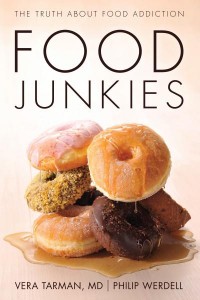Does Food Addiction Require Abstinence?
Tuesday, February 10, 2015 Recently, I had the opportunity of meeting Vera Tarman, a Toronto addiction physician, who is also a self-proclaimed “food addict” and author of the book, “Food Junkies: The Truth About Food Addiction“.
Recently, I had the opportunity of meeting Vera Tarman, a Toronto addiction physician, who is also a self-proclaimed “food addict” and author of the book, “Food Junkies: The Truth About Food Addiction“.
It is fair to say that talking to Tarman and reading her book (of which she happily gave me a copy) has definitely given me food for thought.
To start with, her book “Food Junkies” is not a typical diet book or even a treatment guide to food addiction.
Rather, it is a rather compelling treatise in support of the existence of a discrete and definable subset of obese (and non-obese) individuals who may well be considered “food addicts” and for whom the only viable treatment is complete abstinence from their respective trigger foods.
To put things simply, Tarman (and her co-author Philip Werdell) describes three categories of “eaters” (the following words my attempt at paraphrasing the central ideas as I understand them):
Normal Eaters: this is by far the largest group of individuals with obesity, who may overeat for no other reason than that they like food, are surrounded by food, pay little attention to food, let themselves go hungry, have food pushed on them, and/or really don’t obsess or worry about food at all. Normal eaters can learn to control their eating through education and coaching and by changing the circumstances that foster poor willpower: better sleep, stress management, improving social skills, changing their personal food environment, etc.
People with Eating Disorders: for this group of individuals, obesity is not the primary problem, rather it is just another symptom of the underlying emotional disturbances that drives their “pathological” eating behaviour. The “spectrum” of these disorders ranges from rather mild “emotional eating” to full blown “binge eating syndrome”. The primary driver of their overeating is psychological (e.g. trauma, grief, abuse, etc.). Once the psychological problem is identified and resolved (or managed, e.g. though cognitive behavioural therapy), they can gain control over their eating behaviour, which in turn can help them control their weight problem.
Food Addicts: this group of individuals is literally “addicted” to certain foods (usually foods high in sugar, flour, fat and/or salt) in the same manner that a drug addict would be considered addicted to their drug, with the same clinical signs that range from denial and loss of control, to physical symptoms on “withdrawal” and relapse that can be prompted by minimal exposure, even years after being “clean” or “sober”.
According to Tarnan and Werdel, this grouping has important implications for clinical management.
While a “normal eater” and someone with an “eating disorder” can eventually learn to practice “moderation”, this is virtually impossible for the true addict – the only viable strategy for them is complete and lifelong abstinence (best coupled with a 12 steps program or something similar).
For the true “food addict”, no amount of education, psychological counselling or attempt at “moderation” will ever lead to success. Any attempt to get the “food addict” to learn how to “use” their “drug” in moderation will be as futile as trying to get a drug addict to learn how to use alcohol or heroin (or any other drug) in moderation (the vast majority will fail).
As to how the “food addict” can practice abstinence, the Food Junkie acknowledges that this is difficult but achievable. Obviously, the goal will be to completely eliminate and abstain from the “trigger foods”, which will vary from individual to individual (and people may well bounce around from one food to the next). Nevertheless, a good place to start is probably with foods that contain sugar, flour, are highly processed, high in fat or otherwise “addictive”.
For some it may mean a low-carb, for others a paleolithic diet, or simply a fruit and vegetable-based high protein diet with some fat thrown in for satiety – here Food Junkies discusses the various options, while acknowledging that there is no hard and fast rule – only, that it can be achieved (a point that the authors illustrate using their own stories and those of their patients).
All of this said, the authors are the first to acknowledge that there is much about food addiction that we don not yet know or fully understand.
For one, making the diagnosis is anything but easy – often, this “diagnosis” can only be made when all attempts at “moderation”, despite best efforts, fail.
The authors also accept that we do not know the prevalence of true food addiction – only, that it may be higher than we think.
If nothing else, the book is a quick and fascinating read for anyone interested in the issue – patient or professional.
It certainly has got me thinking about whether or not “abstinence” may indeed be a viable approach for some of my patients.
For anyone, who has questions regarding this concept, Dr. Tarman has kindly agreed to address these in a subsequent guest post on these pages – so please send me your comments/questions.
@DrSharma
Edmonton, AB


